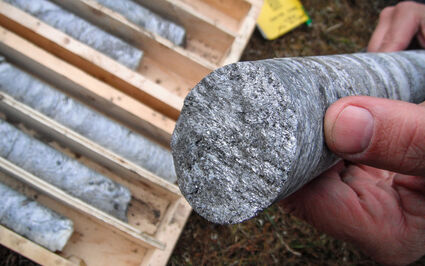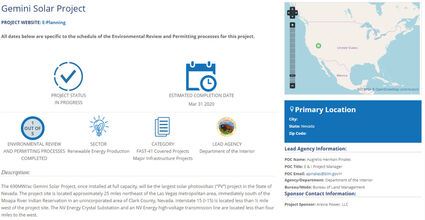Mining eligible for permit streamlining
Federal permitting council votes to include sector for Fast-41 North of 60 Mining News – January 17, 2020
Last updated 9/26/2020 at 11:40am

Graphite One Inc.
Core from drilling through a graphite-rich lens at Graphite Creek. This world-class deposit, which could provide a domestic source for the graphite needed for the lithium-ion batteries used to store wind- and solar-generated electricity, is among the Alaska mining projects that could benefit from more efficient permitting under Fast-41.
It's official, U.S. mining projects can now be considered for more efficient permitting under Title 41 of the Fixing America's Surface Transportation Act, or Fast-41, a program established in 2015 to improve the timeliness, predictability, and transparency of the federal environmental review and authorization process for eligible infrastructure projects.
This Obama-era Fast-41 program established the Federal Permitting Improvement Steering Council (FPISC), a federal entity meant to provide a one-stop-shop capable of coordinating permits across different federal agencies, thereby streamlining and shortening the overall process for some large projects.
On Jan. 15, FPISC voted in favor of including mining among the sectors eligible for the coordination and permit streamlining under Fast-41.
"Today's vote highlights that rebuilding the nation's transit systems, ports and waterways, pipelines and other projects, cannot happen without timely access to raw materials made available through domestic mining," National Mining Association President and CEO Rich Nolan said on Jan. 15. "As the front end of our supply chain, American mining is key to successfully repairing our nation's infrastructure so including mining projects among those covered by Fast-41 is an important first step in addressing permitting delays that have plagued the mining industry for years."
NMA points out that while the U.S. is home to an estimated $6.2 trillion worth of mineral reserves, it is hampered by one of the world's longest permitting processes, which takes an average of seven to 10 years before a major mining project is approved.
"These delays disrupt supply chains and hamper the ability to complete large-scale infrastructure projects on time," the mining association wrote.
Getting mining included as an eligible sector under Fast-41 was prompted by Alaska Gov. Michael Dunleavy, who nominated Graphite One Inc.'s Graphite Creek deposit in western Alaska as a high-priority infrastructure project, as well as USA Rare Earth LLC and Texas Mineral Resources Corp., proponents of the Round Top rare earth element project in Texas.
FPISC Executive Director Alex Hergott introduced the Fast-41 program to the mining sector during a December presentation at the American Exploration & Mining Association's 2019 Annual Meeting in Nevada.
He told the crowd that getting mining on the list was bolstered by concerns expressed by the American Wind Energy and Solar Energy associations, which need the minerals for renewable energy in the U.S.
The FPISC executive director said the long permitting timelines for complex projects, and the frustration that comes with that, can be greatly reduced by encouraging early coordination and synchronization of the myriad of federal regulatory agencies, their state and local regulatory counterparts, as well as the numerous other stakeholders involved in permitting large projects in the U.S.
"The whole idea here is to bring common sense back into this world where we bring all relevant stakeholders to the front end of the process. So that we can actually figure out rules and responsibilities, identify problems, and do our damn jobs," Herggott said.
To be eligible for FSIPC, a project is expected to require more than US$200 million in investment and subject to an environmental review under the National Environmental Policy Act.
"Within 60 days of being on this council we sent a team to fly down to the project. We get all the state, tribal, county and city zoning individuals – all the federal elements that in many cases have only known each other over email for 20 years – we sit them around a table," Herrgott said.
These various stakeholders decide upon a reliable, realistic agreed upon permitting timeline with milestones. Once set, this timeline cannot be altered unless there is a major event that would prevent the project from moving forward.
The council's main tool for ensuring the project stays on this timeline and the agencies are held accountable is the Federal Infrastructure Permitting Dashboard, which tracks the progress of FPSIC-eligible projects.
This dashboard allows government agencies, project developers, and interested members of the public to track the federal government's environmental review and authorization processes for these large or complex infrastructure projects.

www.permits.performance.gov
Gemini Solar in Nevada is one of the projects currently on the Federal Permitting Improvement Steering Council's Fast-41 dashboard, a tool that helps coordinate and track the permitting of major infrastructure projects in the U.S.
More information on the Federal Permitting Improvement Steering Council and Fast-41 can be read in Can DC agency shorten mine permitting? published in the Dec. 6 edition of North of 60 Mining News. The Fast-41 permitting dashboard, which tells more about the program and how to have a project covered is found at https://cms8.permits.performance.gov/.








Reader Comments(1)
Eidolon writes:
Great news!
01/17/2020, 8:33 am